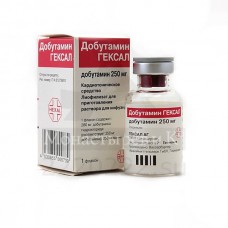Expiration date: 06/2026
The composition and form of issue:
Powder lyophilized for solution preparation for injections to 1 FL.
dobutamine hydrochloride 280 mg (equivalent to 250 mg dobutamina)
in the paper cartons 1 a bottle.
Solution for infusion 1 amp. (50 ml)
dobutamine hydrochloride 280 mg (equivalent to 250 mg dobutamina)
in the paper cartons of 1 ampoule.
Pharmacological action:
Stimulates beta1-adrenergic receptors of the myocardium. Has a positive inotropic effect, moderately increases heart rate, stroke and cardiac output, reduces peripheral vascular resistance and vascular resistance in the pulmonary circulation. Increases coronary blood flow, improves the supply of myocardial oxygen, reduces the filling pressure of the ventricles of the heart.
Pharmacokinetics:
Cmax is reached after 10-12 min. There is a linear correlation between the value of the constant level of concentration and the infusion rate. T1/2 2-3 min, the volume of distribution ~ 0.2 l/kg of body weight, plasma clearance does not depend on the minute volume of the heart and is 2.4 l/min/m2. Predominantly metabolized in the tissues and in the liver (by conjugation with glucuronide, and formation of pharmacologically inactive 3-O-methyl-dobutamine). Excreted in the urine (more than 2/3 in the form of glukuronidov and 3-O-methyl-dobutamine) and bile. Effect develops after 1-2 min after start of infusion.
Clinical pharmacology:
In children is less pronounced decrease in systemic vascular resistance and filling pressure of the ventricles, with more pronounced increase in heart rate and increased blood pressure.
Indications:
Acute heart failure, aggravation (acute decompensation) chronic heart failure chronic heart failure (as a temporary aid on the background of basic therapy), low volume (as a side effect of artificial lung ventilation with positive residual pressure on the exhale).
Contraindications:
Hypersensitivity, idiopathic hypertrophic subaortic stenosis, pericardial tamponade, aortic stenosis, hypovolemia, concomitant use of MAO inhibitors, breastfeeding.
Application of pregnancy and breast-feeding:
Perhaps if the expected effect therapy outweighs the potential risk to the fetus. At the time of treatment should stop breastfeeding.
Side effects:
From the nervous system and sensory organs: headache.
From the cardiovascular system and blood (hematopoiesis, hemostasis): tachycardia (including ventricular), atrial fibrillation, pain in the heart and in the chest, palpitations, shortness of breath, increased blood pressure, hypotension, hypokalemia (very rare), transient inhibition of platelet aggregation (prolonged use), petechial bleeding, phlebitis.
From the digestive tract: nausea.
From the skin: skin necrosis (injection site).
Allergic reactions: rarely — skin rash, fever, bronchospasm, eosinophilia, etc.), polyuria (with the introduction of high doses).
Drug interactions:
Beta-adrenergic receptors attenuate the action (in this case the predominant alpha effects lead to increased blood pressure and vasoconstriction). Sodium nitroprusside or nitroglycerin help to increase the minute volume of the heart, decrease systemic vascular resistance and filling pressure of the ventricles. Welcome dobutamine diabetic increases the need for insulin. The combination with ACE inhibitors causes an increase in minute volume of the heart (chest pain, arrhythmias). When combined with dopamine raises blood pressure, increasing renal blood flow, sodium excretion, diuresis.
Incompatible with alkaline solutions and solutions containing sodium sulphide, ethanol, acyclovir, aminofillinom, bretylium, calcium chloride and gluconate, zefamandola the formate, the sodium salts zefalotina, Cefazolin, ethacrynic acid, diazepam, digoxin, furosemide, heparin, hydrocortisone-sodium succinate, insulin, potassium chloride, magnesium sulfate, penicillin, phenytoin, streptokinase, verapamil.
Method of application and dose:
In/in the drip.
The powder was dissolved in 10 ml of water for injection and then adjusted to 5% glucose solution or other solvents to a volume of 50 ml (intermittent infusion) or 500 ml (continuous).
Solution for infusion: if necessary, further dilution using the same solutions as for the powder. Dose set individually. Usually adults 2,5–10 (40) micrograms/kg/min, children 1-15 mcg/kg/min.
Overdose:
Symptoms: nausea, vomiting, lack of appetite, tremor, anxiety, palpitations, headache, dyspnoea, chest pain, hypertension, myocardial ischemia.
Treatment: cessation of drug administration, ventilation, when ventricular tahiaritmii — appointment of propranolol or lidocaine, when erroneous oral administration — administration of activated charcoal.
Precautions:
Be used with caution in children (due to lower their latitude therapeutic action). During treatment required numerical control, the minute volume of the heart, AD venous pressure and the pressure in the pulmonary capillaries, the amount of urine passed.
In the treatment of patients with diabetes need to control glucose levels in the blood.
Special instructions:
With continuous administration of the drug (more than 72 h) could develop the phenomenon of tolerance (need increasing dosage of the drug).
Dissolved in water for injection lyophilized powder dobutamine before further dilution should be stored at 2-8 °C for no longer than 48 h, and at room temperature for no more than 6 h. Further dilution should be made just before use of the drug. Cooked solution should be used within 24 h


